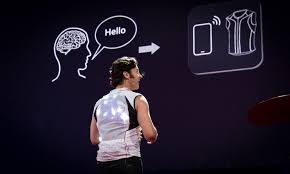January 2019 Meeting Notes

On 2019-Jan-5, we watched a portion of a famous 2015 TED Talk video on Sensory Substitution by David Eagleman. David is a well-known developier of aids for disabled persons, among other things. See David Eagleman’s TED Talk.
A treatment to stop PN’s neuron death could come soon or not for a long time. There seems to be nothing on the immediate horizon. Even if a treatment stopped all further cell death, there are millions of Americans already severely disabled. SO, is there nothing that can be done for the severely disabled or those about to be?
The video shows how external sensors can be relatively inexpensively added and used by our brain to replace senses (like sight and hearing) that have been lost or absent. The external sensors demonstrated (in this case, for hearing loss, via a phone app and vibrators in the vest worn in the photo above) do not require expensive surgery or complicated computer systems. Sound ridiculous? Watch the video!
Below are some questions we discussed, with group response shown in [brackets]:
- Could this be done to replace some of the sense neurons we lose with PN? [Perhaps]
- How might such senses be attached? [Shoes that signal to vibrators in a vest or leggings?]
- What sensations might we want to replace? [Proprioception & pressure sensors in feet & legs. Others?]
- How expensive would they be? [Doesn’t sound horrible]
- All of Eagleman’s examples required a “feedback” source to show the brain what a “correct” response is so the brain can learn how to use the new artificial sensor. What would “feedback” be for an artificial balance sensor? If other sensations (touch, heat/cold, damage) could be added artificially, what feedbacks would they use?
- Replacing sensory input is only half the problem. PN also robs us of the neurons needed to control our muscles, leading to muscle weakness and failure to balance and walk. We showed some examples of “external” skeletons (exoskeletons). Where might this technology go in the future? [We talked about proposals to create exoskeletons using “smart clothing” with the ability to act as muscles]
- European insurance and government health plans are already considering or approving the use of some exoskeletons (in special cases). What could be done for that to happen in the US?
- If science could design either new sensors or new “muscles” what can we (members of a support group) do to make that happen sooner?
A practical example of the Eagleman concept
In the meeting, one member showed us her new strap-on flexible brace. She said it helped her balance a lot. I have advocated use of inexpensive devices like the Ossur “Foot-Up,” in lieu of braces, to lessen the risk of tripping because of foot-drop. But the “Foot-Up” (discussed elsewhere on this page) only addresses foot-drop, not balance. Can a flexible brace serve to transfer sensory information that we have lost from our feet to sensors we still have higher in the calf?
